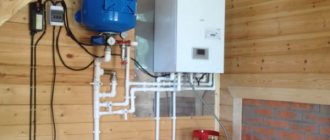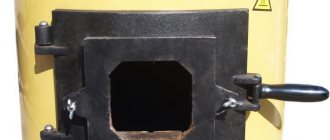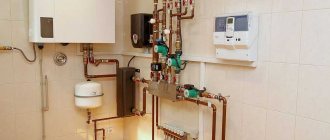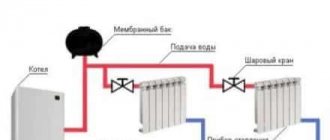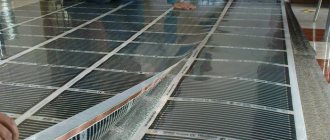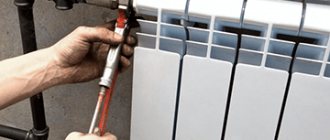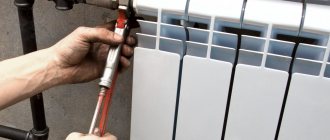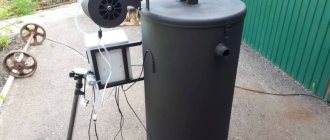It’s quite a common occurrence that when building a country house, the owners do not create any kind of detailed, “classical” heating system. The considerations are clear - during the very season of dacha life it is simply not needed, with the arrival of cool days - electric heaters come to the rescue. Well, when it gets really cold, dacha life freezes until spring comes, and the family moves to their heated city “residence.”
Is it possible to heat a house with heaters and how much does it cost?
But many dacha owners like to go there in the winter - on weekends or on the traditional long New Year and Christmas “vacations”. And a house that has stood without heating, even for a week, no matter how well it is insulated, will still get cold during this time. Will existing electric heaters help to quickly “breathe life” into a frozen dacha during a winter visit? Or, let’s put it another way: is it possible to heat a house with heaters and how much does it cost?
Spoiler alert: success is not guaranteed in all cases, and it comes at a high price.
Gas boilers
The water heating system is the most common for heating residential premises. Its meaning lies in the use of a coolant based on the circulation of water in the system.
It is often based on a gas boiler, which can be wall-mounted or floor-mounted. The wall-mounted boiler is a thermoblock that includes expansion and circulation pumps, a heat exchanger, and an automatic system.
Such boilers are double-circuit. The floor-standing boiler is single-circuit and includes a pump that supplies heated water to the heating system.
One of the important advantages of gas heating is ease of use and safety. Modern gas boilers are prudently equipped with an automation system that ensures safety, even in the event of flame extinction, and prevents gas leakage.
The disadvantages include:
- Long and labor-intensive registration of permission to use gas equipment.
- Allocation of a separate room for installation of a gas boiler, equipped in accordance with the requirements.
- The presence of a chimney and good ventilation.
- You must obtain permission from the fire inspectorate for installation.
Also, it should be taken into account that using gas boilers in a room of less than 100 square meters is unprofitable.
How much does it cost to heat a house? Calculation scheme.
When choosing a heating system, follow the following calculation scheme:
- decide how many rooms or square meters need to be heated;
- what result is needed: temporary or permanent;
- is there gas heating;
- Are you ready to combine stove and electric heating;
- what is the heat output?
This check will help sum up the question: how much does it cost to heat a house with electricity? Pay attention not only to how much a particular installation or heater will cost, but also what related materials will be needed:
- additional rooms for a boiler room;
- fuel storage tanks;
- purchase of high-quality solid fuel;
- a place for storing solid fuel with protection from moisture, etc.
Let us present the mathematical calculation scheme in an averaged version. We take into account a house of 50 sq.m. and heating season 6 months. If your house is 100 sq.m., multiply the result by 2, 150 sq.m. - by 3, etc. Taking into account the different costs of gas, electricity and various types of fuel in the regions of the Russian Federation and the CIS, the scheme is very approximate, but we make the following general calculations:
Gas heating:
- Standard gas boiler . Natural gas consumption 2m³/hour * 2160 hours (6 months) * gas cost in your region / 0.93 (93% efficiency). For example, the cost per cubic meter. meter of gas is 9.25 rubles, which means the calculation will be as follows: 2 m³/hour * 2160 hour * 9.25 rubles / 0.93 = 42968 rubles for 6 months. This means an average of 7161 rubles per month.
- Condensing gas boiler . 2m³/hour * 2160 hours * gas cost in your region / 1.07 (efficiency 107%)
Electric boiler
- A heating element electric boiler consumes an average of 7000 kW/hour per month * the cost of electricity in your region = the cost of heating per month
- An electrode electric boiler consumes 4200 kW/hour per month * cost of electricity in your region = cost of heating per month
Liquid fuel
Average consumption per season is 2 l/hour * 2160 hours (6 months) = 4320 liters * cost of diesel in your region = cost of heating with liquid fuel for the entire season
Solid fuel
- Wood (firewood) with a solid fuel boiler power of 20 kW burns about 9 kg of fuel per hour (if we take into account the efficiency of 80%): 2160 hours * 9 kg/hour = 19440 kg (19.4 tons). Price per ton of firewood in your region * 19.4t = cost of heating with wood per season. Don’t forget to add to this amount the cost of delivering firewood to your home.
- Coal 2160 hours * 4 kg/hour = 8640 kg (8.64 tons) * price per ton of coal in your region = cost of heating with coal for a season of 6 months. Also consider the cost of delivering coal to your home.
Electric boiler
Electric boilers are also used in water heating systems.
The principle of their operation is similar to that of a gas boiler, but operates using electricity. The advantages include:
- No chimney or separate room is required.
- Installation requires minimal documentation and does not take much time.
- Simple installation allows you to do without specialists.
Minuses:
- It is beneficial to use in small rooms , as the high cost of high energy consumption.
https://www.youtube.com/watch?v=2M_qMJoszUs
Blitz tips
- Using a pump in a heating circuit with an electrode heater increases the efficiency of the system by up to 20%.
- To connect an electric boiler, it is necessary to lay a separate line from the input distribution devices with subsequent grounding.
- To install electric boilers with a power of more than 10 kW, permission from energy supervision services is required.
- Heating a large room with one heater will not be effective , so several such devices should be installed simultaneously.
- It is not recommended to install heating devices near windows.
- Solar collectors usually serve as an auxiliary heating system, since they do not raise the temperature in the house to the optimal level in winter. Solar heating can be used as a primary system in regions where the sun shines at least 180 days a year.
Pellet boilers
Pellet boilers are becoming popular for use in heating systems.
The meaning of their work is to obtain energy by burning special granules - pellets . These pellets are made from sawdust, straw, and husks by pressing under pressure.
There are also peat pellets. Boilers using this type of solid fuel have a specific design and are designated as pellet.
They consist of the following parts:
- Enclosures with automation and connections to the heating circuit and chimney.
- A firebox with a heat exchanger and equipped with a chimney.
- Bunker for pellets.
- A mechanism that ensures the supply of pellets to the burner.
- Burners for pellets.
After the pellets enter the burner, they are ignited. This is usually achieved with the help of a small TEN and forced ventilation. The resulting heat from combustion of pellets heats the heat exchanger and the water in it. The water, in turn, begins to circulate through the heating system. Accordingly, such boilers are also used in water heating systems.
Principle of operation:
Principle of operation
The advantages of pellet boilers include:
- Possibility of high automation of the heating system. For example, using an electronic heating unit, you can set the selected operating mode for the desired period.
- Some types of pellet boilers are non-volatile , which is their advantage and allows you to save energy.
- fuel storage facilities
- When pellets are burned , virtually no ash or soot remains.
The disadvantages include:
- The cost of pellets is often high .
- A chimney is required.
- Ensuring control over the number of pellets in the bunker and adding them.
- Mandatory cleaning once a month.
- In addition, these boilers are floor-standing and take up a lot of space.
In general, water heating has a number of pros and cons. The advantages are - uniform heat distribution in relatively small rooms, the ability to limit the upper temperature limit.
An obvious disadvantage is the possibility of freezing water in the pipes and radiators of the heating system, which will inevitably lead to their damage after defrosting. High hydrostatic pressure and thermal inertia are also disadvantages.
What are the possible reasons for failure?
Background to this publication
To tell you the truth, what prompted me to sit down to write these lines and compile a calculator (which we will get to below) was reading a small article on Yandex-Zen, with approximately the same title as the one in the title of this publication. There, the author (apparently a young, pretty woman) says that she and her husband decided to install electric heaters at their dacha, and connect them to the Smart Home system, which provides remote control capabilities, via GSM or IP channels, it doesn’t matter.
Smart home systems with the ability to remotely control functions can allow you to turn on the heating in advance and arrive outside the city to an already warmed-up home.
And then one day, preparing to traditionally come out of town for the weekend on Friday evening, they turned on the electric heating in advance so that upon their arrival the rooms would have a comfortable temperature - plus 22 ℃. At the same time, it is reported that at the time of launch it was minus 2 ℃ outside, and in residential premises, which had been practically completely chilled since the previous visit, it was plus 1 ℃.
Some data is also provided on the “grouping of heaters” - two quartz wall panels of 400 W each, one in each bedroom, and another infrared (without specifying which) “kilowatt” in the third room, apparently an attic.
According to the description, the house is enclosed in very effective thermal insulation - both the walls, the roof, and the floors of the first floor.
So, this is happening in November (not winter yet). The housewife turns on the heaters remotely in the morning, with the goal of reaching a comfortable 22 degrees, with the expectation that she will arrive in a warm house in the evening. But after 11 hours of continuous operation of the devices in the two lower rooms (with an area of approximately eight “squares”), we managed to reach 11 degrees, in the upper attic, with a kilowatt heater, it was 13.
The conclusion is that there is not enough power, let’s increase it exactly twice as much and we will reach the cherished 22 degrees. Today, 20 kW of electricity was consumed in 11 hours, which amounted to expenses in monetary terms of about one hundred rubles. Let it be 40 kW - it’s not a pity to spend 200 rubles once a week to warm up the house.
And everything will work out!
* * * * * * *
Well, let's think about it.
The result, which so surprised the author of that article, seems quite logical - we will talk about this later. As for the conclusion drawn, everything is also very, very controversial. It is possible that the experiment will end with the same result: warming up to the set temperature will still not happen.
Warming up and replenishing heat losses - what's the difference?
The owner of the dacha describes her devices as some kind of branded heaters (without instructions they cope with maintaining heat in a room brought to the optimal temperature. They say that there are already precedents for this.
Apparently these or similar quartz heating panels with a power of 400 watts are meant. The heaters are not bad, but they are far from “magical”.
Well, first of all, let’s repeat, it hasn’t been winter yet. And secondly, do not confuse warming up a cold house with the current replenishment of heat losses.
Let me explain. In a house where people constantly live, there is almost continuous additional “heat generation”. Every person is a “walking stove” with a temperature of 36 degrees. In addition, residents give off a lot of heat through the warm air they exhale.
Further, a person does not just lie on the sofa and “warm the air.” Many of his activities also involve some form of heat production. Food is being prepared in the kitchen, hot water is heated and used for household and hygienic purposes, large and small household appliances are running, etc. All this is accompanied by a very considerable release of heat, and in total a quite decent debit of thermal energy is obtained. So in the summer you also have to get rid of it somehow - with air conditioning.
If it is colder outside than in the house, the heat loss mechanism turns on. That is, according to the laws of physics, heat exchange processes will begin, seeking to equalize the temperature. The heat begins to escape outside, finding many loopholes. The better the thermal insulation of building structures, the less these losses become, of course. But completely getting rid of them is almost impossible.
Even in very well-insulated houses, heat still finds its way out. This is clearly noticeable when examining a house using a special device - a TV.
By the way, in general, permanent residences enter the heating season very smoothly in this way - without any jumps. And what kind of jumps can there be? – the rooms were warm, and a very small supply of energy compensated for the still insignificant heat losses. As the weather gets colder, leaks increase and so does compensation.
Expert opinion: Afanasyev E.V.
Chief editor of the Stroyday.ru project. Engineer.
So that's what's important! When designing heating systems, the calculation of the required influx of thermal energy (system power) is carried out precisely according to the amount of heat losses to be replenished. More specifically, the calculation is carried out for the coldest ten-day period of winter, that is, at the peak of frost, when heat losses usually reach their maximum. It is clear that, as a rule, such cold temperatures do not last all winter, but thereby a certain operational reserve is built into the capabilities of the heating system. In other words, it must be ready “fully armed” to meet the most severe frosts characteristic of a particular region.
I don’t consider this to be some kind of rule, but with a certain degree of certainty you can estimate the heating power as 1 kilowatt for every 10 “squares” of area with a normal ceiling height of 2.7 ÷ 3.0 meters.
Let’s put it this way: for first estimates, you can use this ratio...
What do we see in the example presented? The room has an area of 8 m², and it contains one electric heater with a power of 400 watts. That is, approximately half of the conventional “norm”. Once in November the temperature outside is negative - this is clearly not the southern region. This means that the heater’s power is not even enough to replenish heat loss. How can we warm up a room “from scratch”?
Yes, on previous visits, as the hostess writes, after heating the room with the stove, the panel allowed us to maintain a normal temperature during the night. Let us repeat - it is still autumn, there are no frosts, or they are in the “infancy phase”. The house is wooden and well insulated - there can’t be any big losses yet! Nevertheless, they are there - turn off the device, and after a couple of hours the room will feel cool, and then more so. Within a week, as we can see, he got completely cold.
Expert opinion: Afanasyev E.V.
Chief editor of the Stroyday.ru project. Engineer.
In severe frosts, one such panel will clearly not be enough. And, I assume, the planned doubling of power is unlikely to save the situation even with the replenishment of heat losses. After all, if you take the calculation seriously, you may get more than the “sacramental” 8 m² × 100 W/m = 800 W = 0.8 kW. Much depends on third-party factors, the climatic conditions of the region, and the characteristics of both the building as a whole and each room in it.
And even more so - such power will almost certainly not be enough to warm up the cold room. Let's explain why.
It must be assumed that warming up, at a minimum, implies bringing the air temperature in the room to the expected one. That is, to heat the volume of air in the room you need to spend a certain amount of heat - all this is quite easily calculated based on the heat capacity of the air and its density.
Even with the windows and doors closed, natural ventilation processes still occur non-stop in a private house. And with the slowest movement of air within an hour, at least a complete exchange occurs. That is, you will have to heat not one volume, but at least two.
But here’s the main thing: for the period of time that the volume of air will heat up, no one will “turn off” the heat loss with a wave of the hand. And the heater will have to cope with two functions - warming up and simultaneous replenishment of heat losses. And here its power may already be catastrophically lacking.
And that is not all. We have so far considered a “light” version of heating a room - only the volume of air. But here there are cold walls, floors, flows, pieces of furniture! And they also need to be brought to some stable warm state. It turns out that when they heat up, they take heat from the air. (Some infrared heating devices act in the diametrically opposite direction - optically opaque objects are heated by radiant energy, which then “share” the heat with the air).
The “mechanism” of operation of different electric heaters can be very different. Thus, convectors, heat fans, oil radiators are to a greater extent “sharpened” to warm up the air, which then heats the environment. Infrared emitters, on the contrary, heat objects, which then transfer heat to the air. But the amount of energy does not change from this!
And if the amount of energy for heating the air, and the time during which it will be generated, is not difficult to calculate, then taking into account the heating of all objects, it is extremely difficult! You will need to know their area, mass, heat capacity of materials - in a word, it’s better not to get involved. Therefore, it is extremely difficult to give any forecast in this regard.
One can only hope that if the power of the heating system (for a specific room) is calculated correctly, that is, it is not lower than the maximum value of heat loss, then it can still work out. Due to the same operational reserve mentioned above. And the warm-up will not last long.
If the power of your heater does not reach the design value, then you may survive a mild winter. But warming up a cold room using such a device is an empty hope. You can turn it on for two, three hours, a day, two - and still the temperature in the room will reach some value insufficient for comfort and “dry out” at this level. This will mean that the heat inflow has stabilized with the current heat loss, but one cannot count on more.
But at the same time, the electricity meter, of course, will continue to increase your payment bill. And you can’t get by with sums of 100 - 200 rubles...
* * * * * * *
Before moving on to the practical part of the publication, it seems important to make one more remark.
Don't believe fantastic promises!
Analyzing everything told by the author of that article, we can say with a certain degree of confidence about one of the hidden, underlying reasons for the failure.
So, as the presentation progresses, one gets the impression that the author talks about his quartz panels almost with some kind of “aspiration.”
And the Internet is full of advertisements for such heaters, and they “blindly” state that these are absolutely exceptional devices that provide from 10 to 50% savings in their cost with (hereinafter quoted) “much lower electricity costs” compared to other electrical appliances.
However, they are not alone. Something similar can be found for any other heating devices - fan heaters, convectors, IR emitters, and even oil radiators. With slightly different vague justifications - but still boiling down to the thesis “we are the best and the most economical”!
Expert opinion: Afanasyev E.V.
Chief editor of the Stroyday.ru project. Engineer.
And people believe! How can they tell lies on the Internet? So it turns out that instead of choosing a truly efficient device, they buy a “magic device that is two or more times more effective.” For example, a fan heater with a power of 380 W, with the promise to warm up 23 “squares” (this has happened!) And then they have what they have.
It’s interesting that under that very article there is a whole “tail” of heated discussions. Moreover, most commentators are drawn into a squabble about which electric heaters are better and more efficient with equal consumption. It’s funny that advertising agents immediately appeared in the discussion, advocating for their products.
Expert opinion: Afanasyev E.V.
Chief editor of the Stroyday.ru project. Engineer.
And only a few sane people say it! Namely, that it is completely pointless to expect miracles in this area. Simply because the law of conservation of energy operates without making exceptions for anyone. It was finally formulated back in the century before last, and there is still no evidence that anyone has refuted it. So, almost 200 years after its discovery, a literate person should be ashamed to believe in some kind of advertising fairy tales.
One of the fundamental physical quantities of the International System (SI) – joule (J) – was named in honor of this great scientist. It is also used to express heat quantitatively.
Remember, and pass it on to others - if, say, 1.6 kilowatts of thermal energy are required to warm a room or for its current heating needs, then they should be supplied here. The conversion of electrical energy into heat is carried out almost without loss - for most devices the efficiency is close to 95÷100%. That is, relatively speaking, you will need to spend about 1.6÷1.7 kW of electrical energy. And whether it is spent by an infrared emitter, a quartz panel or a convector is secondary, and ABSOLUTELY ANY advantages in terms of savings.
One can still argue in terms of the feeling of comfort at the initial stage of warming up the room. For example, an IR emitter will warm exposed skin like the sun, but the air will remain cool for a long time. The fan heater will create a “warm wind”, but outside this sector it will be very uncomfortable. You can sit comfortably in a chair near the oil radiator, feeling the warmth radiating from it at a short distance. And so on. But different devices of the same power will reach the “common denominator”, that is, complete heating of a specific room under specific conditions, almost simultaneously.
Don't believe me? - your right! So, experiment, prove the opposite. Maybe someday some physical quantity will be named after you for this...
Video: “Low blow” for lovers of miracles
Features of the operation of heat guns
This heating method is effective in large rooms where there is no permanent heating system.
Often, heat guns are used to heat industrial premises. The operating principle of this equipment is heat exchange between heated air and a heat gun. The supply of warm air is provided using a fan installed in the device or due to natural convection.
Heat generation is achieved by burning fuel - gas, kerosene, waste oil or hydrocarbon fuel. There are also electric heat guns.
Different methods of heat generation determine different models of heat guns.
Pros of heat guns:
- Equipped with a thermostat that allows the device to automatically turn on when the temperature drops.
- The protection system prevents overheating and will last a long time.
- The device is quite economical.
Minuses:
- Large dimensions of diesel and gas heat guns.
- Some types of these devices are not environmentally friendly
These types of heating devices include fan heaters. The principle of their operation is similar to a heat gun, but they are more compact in size and are designed to work in small spaces.
Comparative analysis based on other criteria
In addition to the questions: the cheaper it is to heat a house, fuel consumption and efficiency, various heat generation options can be compared according to other parameters:
- From an environmental point of view, it is better to use equipment that runs on electricity. Then there is a gas boiler and combined gas-electricity systems.
- Electric convectors and infrared emitters have advantages in terms of complexity and cost of maintenance. The most demanding in terms of this parameter will be solid fuel systems, which require daily cleaning and loading.
- In terms of installation complexity, hybrid systems rank first, for example, solar collectors - gas boiler. The easiest to install is electrical equipment, followed by solid fuel boilers. Gas devices are installed, tested, and serviced only by special organizations and require a large number of permits.
- According to safety criteria, any heating system can lead to unpleasant consequences if used incorrectly. Possible electric shocks, fires, and gas explosions.
Nuances of operation
Heating systems have their own operating characteristics depending on the quality of installation and type of equipment.
Systems of the same type work differently because:
- fuel of a different quality is used;
- coolant parameters differ;
- a local zone of low pressure has formed in the expansion tank;
- air is sucked into the circuit due to a leak;
- air diffusion occurs through the surface of pipes made of plastic;
- During the installation of the pipeline, plugs were allowed to form, for example, when soldering pipes.
About fuel storage
To prepare a supply of firewood for the entire season, you will need a room protected from moisture. Coal, briquettes and pellets also require special storage conditions.
To contain liquid fuels, you will need a plastic or metal container, which should not be in the basement.
Equipment service
Primary and additional heating in a cottage or private house require periodic inspection, repair and replacement of components. The following signs indicate the need for work:
- Coolant is leaking from radiators and pipes;
- seething or noise is heard in the system;
- uneven heating in different rooms and floors;
- The system functions worse than at startup.
Possible causes of problems:
- design errors;
- the tightness of the connections is broken;
- Radiators are installed incorrectly;
- air pockets interfere with coolant circulation;
- equipment was installed in bad faith;
- due to incorrect connections, the system was unbalanced;
- use of low-quality components.
Heat generators
Heat generator “Bison”
The heat generator is a modified centrifugal pump. There are two types of heat generators - rotary and static. There are heat generators for air and water heating.
The principle of operation of a water heating heat generator is that the heated coolant is supplied by a pump to the heating devices. They release heat and lower the temperature of the coolant. Then, the coolant is returned back for subsequent heating. The coolant can be water or antifreeze.
An air heating generator works on the principle of a heat gun, heating the air and sending it through the ventilation ducts. They are used mainly in industrial, agricultural and warehouse premises.
Depending on the type of fuel, there are diesel, gas and solid fuel heat generators.
The disadvantages of most heat generators are noise, large size and too much power for small rooms.
Stove heating
There are two types of stove heating:
Regular traditional
It is heating through the use of released energy, which is achieved during the combustion process. This stove has a classic appearance with a firebox, chimney and ash collector. Such stoves heat only small rooms and take up a lot of space; they require constant addition of a combustion product (coal and wood), which are disadvantages.
Greater inertia, provision of a chimney and constant control of combustion can also be considered disadvantages. The advantages include: heating and cooking food using an oven, the ability to build it with your own hands, use in places where there is no gas or electricity, and the function of some room decor.
Water heating
Achieved by connecting a heat exchanger with a water circuit to the firebox of the stove , connected to a water heating system. A distinctive advantage from the previous type is the heating of large rooms.
Based on their functional features, stoves are divided into heating stoves, heating and cooking stoves, and fireplace stoves. They come in metal and brick.
https://www.youtube.com/watch?v=aB1duN9-N4c
Fireplace as a type of heating
There are several types of fireplaces:
- Built-in – fully equipped in the wall.
- Wall-mounted - most of them are hidden by an additionally constructed wall.
- Free-standing (island) . Such fireplaces are usually placed in the center of the room.
Based on the type of combustion part, fireplaces are divided into open and closed types. With one, two or three radiating surfaces. A cheaper option with one surface, and it also has higher heat transfer. A fireplace with three radiating surfaces is the most inefficient and expensive, but is considered more aesthetically pleasing and beautiful.
To achieve heating results with a fireplace, it must be built with two fireboxes, then the fireplace has the function of a stove.
The advantages of such heating include:
- Uniform and fast heating of the room.
- Long-term heat retention.
- Decorative function.
Minuses:
- They take up a lot of space , especially island fireplaces.
- The device requires the connection of professional workers.
- Possibility of precipitation entering through the chimney pipe.
There are also electric fireplaces that operate on electricity. Such fireplaces have several levels of heating, do not make noise, do not require a chimney, are a bright addition to the interior, but require a lot of energy consumption.
Results
To summarize, it can be noted that gas-powered devices are the cheapest to operate. In second place in terms of cost are pellets. Coal and firewood are already more expensive fuels.
Electricity completes this list. When choosing equipment for heating a room, you need to weigh all factors, such as pricing, the possibility of self-installation, complexity of use, availability of free space, etc. With the right approach, you can create an alternative to other types of heating and get an economical and convenient heating system.
Firewood
By default, they are the cheapest type of fuel in almost any region. Even if you buy them ready-made - sawn and chopped. And if it is possible to prepare them yourself, then price as a selection criterion can be completely neglected. This fuel will cost you 4 times less than the much-vaunted natural gas.
However, as can be seen in practice, not everyone prefers this type of fuel, despite such attractive savings. There are several reasons for this.
Firstly, the efficiency of wood-burning boilers is not very high, even among advanced models with pyrolysis and other innovations. Secondly, firewood ranks third from bottom in the ranking of fuel types in terms of convenience. They need to be stored somewhere, that's it. Only dry firewood burns well and quickly heats rooms, that’s two. They need to be regularly dragged into the boiler room, that's three. The firewood itself will not be loaded into the boiler; you will have to do this yourself several times a day, that’s four. Finally, the wood-burning boiler and its chimney system require regular maintenance. Especially if you are using not completely dry firewood.
The conclusion is this. If you don't mind the hassle of storing and using firewood and want cost-effective heating, then this is your option. This is also your option if there is no natural gas nearby, or it is unrealistic to obtain sufficient power for your use.
